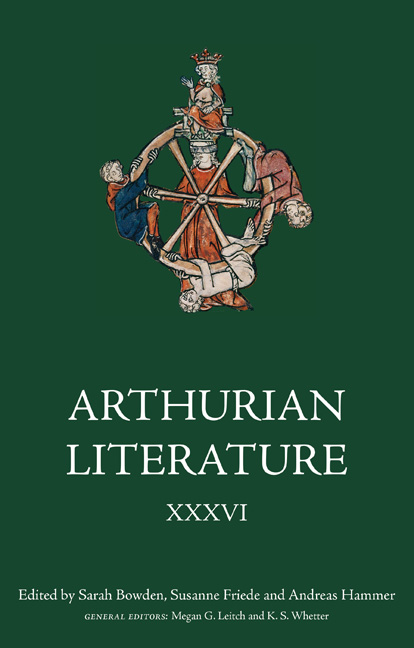Book contents
- Frontmatter
- Contents
- General Editors’ Preface
- List of Contributors
- Introduction: Sacred Space and Place in Arthurian Romance
- 1 The Church and the Otherworld: Sacred Spaces in the Matière de Bretagne and Medieval Ireland
- 2 Sacred Spaces: the Syntagmatic and Paradigmatic Construction of Narrated Space in Chrétien’s Conte du Graal
- 3 Perceiving the Way: Sacred Spaces and Imaginary Pilgrimage in the Vulgate Cycle Queste del Saint Graal and Thomas Malory’s ‘Tale of the Sankgreal’
- 4 Affirming Absence and Embracing Nothing: on the Paradoxical Place of Heterosexual Sex in Medieval French Verse Romance
- 5 Spaces of Remorse: Penitential Allusions in Iwein
- 6 The Spatial Narratives of Salvation and Damnation in Wigalois and the Prose Lancelot
- 7 ‘Fantoum and Fayryȝe’: Visions of the End of Arthurian Britain
- 8 The Tomb of the Kings: Imperial Space in Arthur’s Camelot
- Contents of Previous Volumes: Details of Earlier Titles are Available from the Publishers
2 - Sacred Spaces: the Syntagmatic and Paradigmatic Construction of Narrated Space in Chrétien’s Conte du Graal
Published online by Cambridge University Press: 17 April 2021
- Frontmatter
- Contents
- General Editors’ Preface
- List of Contributors
- Introduction: Sacred Space and Place in Arthurian Romance
- 1 The Church and the Otherworld: Sacred Spaces in the Matière de Bretagne and Medieval Ireland
- 2 Sacred Spaces: the Syntagmatic and Paradigmatic Construction of Narrated Space in Chrétien’s Conte du Graal
- 3 Perceiving the Way: Sacred Spaces and Imaginary Pilgrimage in the Vulgate Cycle Queste del Saint Graal and Thomas Malory’s ‘Tale of the Sankgreal’
- 4 Affirming Absence and Embracing Nothing: on the Paradoxical Place of Heterosexual Sex in Medieval French Verse Romance
- 5 Spaces of Remorse: Penitential Allusions in Iwein
- 6 The Spatial Narratives of Salvation and Damnation in Wigalois and the Prose Lancelot
- 7 ‘Fantoum and Fayryȝe’: Visions of the End of Arthurian Britain
- 8 The Tomb of the Kings: Imperial Space in Arthur’s Camelot
- Contents of Previous Volumes: Details of Earlier Titles are Available from the Publishers
Summary
Contemporary theoretical discussions of the spatial constitution of narrative texts are often founded on the assumption of a kind of contextual framework, which can ‘describe a mental store of information about the current context, built up from the text itself and from inferences made from the text’. It is absolutely not the case that narrated space – in either contemporary or medieval texts – is conceptualized according to a generalized conception of spaces. Instead, information given by the contextual framework ‘provides “episodic” information about a configuration of characters, location and time at any point in a narrative’. Specific information about individual characters and individual places within the space–time continuum is embedded in this contextual framework and linked to individual episodes.
The spatial ‘reality’ described in fictional narrative texts by no means automatically maps on to the conceptualization of space in contemporary lived experience. In the medieval context, anything that might be called an ‘ordinary’ human understanding of space is also largely beyond our grasp. With the exception of some isolated examples of maps, our only option is to turn to the surviving corpus of written texts: as such, we nearly always deal with a narrated space. This state of affairs means in turn that our analysis must focus on how the narrated space is produced by the text and its narrating voices.
Yet – in the context of this collection – it is necessary to differentiate between places (or locations) and spaces (or realms). Broadly speaking, places are to be understood as clearly defined spatial entities concretely located in space (and potentially in time), which are conventionally described in precise terms. Spaces, in turn, are characterised by a kind of expansion on what we might think of as a spatial ‘axis’, or an area within the narrated space, for example, the entirety of a text, as a whole, if imagined in cyclical terms. The role of such spaces in written texts – in this case, Arthurian romance – is normally linked to the largely linear movement of the protagonist, who passes through a specific space or stays there for a certain period of the narrated time.
- Type
- Chapter
- Information
- Arthurian Literature XXXVISacred Space and Place in Arthurian Romance, pp. 31 - 56Publisher: Boydell & BrewerPrint publication year: 2021



